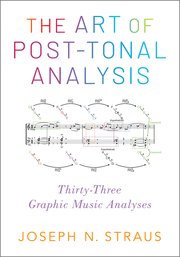
OXFORD UNIVERSITY PRESS - 19
Art of Post-Tonal Analysis
Author: Joseph N. Straus
Publisher: Oxford University Press
Art of Post-Tonal Analysis
Juilliard Store
144 West 66th Street
New York NY 10023
United States
Choose options
Art of Post-Tonal Analysis
Juilliard Store
144 West 66th Street
New York NY 10023
United States
Art of Post-Tonal Analysis
Juilliard Store
144 West 66th Street
New York NY 10023
United States
Thirty-Three Graphic Music Analyses
Joseph N. Straus
- Offers extensive, richly illustrated music examples, plus an accompanying website of analytical videos
- Provides a welcoming pedagogical approach
- Makes accessible a close engagement with challenging modernist music
The Art of Post-Tonal Analysis consists of analyses of thirty-three musical passages or entire short works in a variety of post-tonal styles. For each piece author Joseph N. Straus shows how it is put together and what sense might be made of it: how the music goes. Along the way, he shows the value of post-tonal theory in addressing these questions, and in revealing something of the fascination and beauty of this music. The works under study are taken from throughout the long twentieth century, from 1909 to the present. Within the atonal wing of modern classical music, the composers discussed here, some canonical and some not, represent a diversity of musical style, chronology, geography, gender, and race/ethnicity.
Musical examples, plus a companion website full of analytical videos, carry the burden of the analytical argument, with rarely more than a few sentences of prose at a time. In writing these analyses, Straus imagined teaching these pieces to a class of undergraduate or graduate students, seated at the piano, pointing at score, listening as they go--the book is intended as a record of these (hypothetical) classes. His approach could be loosely described as transformational, rooted in an interest in seeing how musical ideas (shapes, intervals, motives) grow, change, and effloresce. When musical ideas are obviously dissimilar and possibly in conflict, the book teases out subtle points of connection between them. Above all, the book aims to create rich networks of relatedness, allowing our musical minds and musical ears to lead each other along some of the many enjoyable pathways through this challenging and beautiful music.
